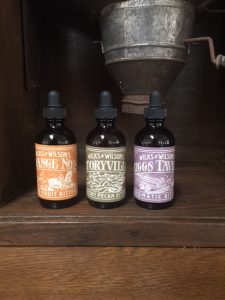A little bit about Bitters!
Bitters have a turbulent history, and it’s not clear when and where it started. Initially invented as a medical treatment, bitters have developed to being a luxury drink in the western culture. As a result, bitters became an essential part of cocktails, but then were forgotten about, or banned. This is why only since recently, bitters are making their way back into the bars and restaurants all over the world.
Bitters as a medical treatment
Until the 19th century, bitters were mainly used as a medical cure-all. It is however, unclear where the idea of making bitters had its origin. Perhaps the first ever bitter was invented by a lucky accident, when certain foods containing bittern maybe fell into a container with strong alcohol, and were forgotten in it. The blend then must have macerated over time, and eventually resulted in a bitter drink.
Author David Wondrich, publisher of various books on cocktails and their history, supports a different theory that states that bitters were developed on purpose, because the knowledge of both herbs and alcohol being a medical remedy was already widespread in the 12th Century. In Wondrich’s opinion, mixing both these compounds to create something new was no big step for alchemists. Trusting this theory, the birthplace for bitters would be Mesopotamia, which is now known as Iraq. In the 9th or 10th Century, the alembic for the distillation of alcohol was invented by Abu Bakr Muhammad ibn Zakariya ar-Razi, who distilled pure alcohol from wine for the first time in history.
Bitters as a flavouring agent
How was the former medical elixir discovered for the seasoning of meals? David Wondrich reports that in the 17th century, pharmacist Richard Stoughton from London advertised his „Magnum Elixir Stomachicum“ as a suitable flavouring agent in Canadian wine or sherry that could also cure a hangover. This story is similar to the history of Peychaud’s bitters, which were invented by pharmacist Antoine Peychaud, and sold to be enjoyed with cognac. This means that historically, it wasn’t bitters that were added to flavour spirits, but the other way around, in order to make bitters edible.
Also, this way the first ever cocktails were invented, and bitters became a seasoning add-on for drinks. Bitters are essential components of the most classic and famous cocktails, for example the Manhattan, Old Fashioned, and the Sazerac. We believe that these drinks would be ordered even more often, if bartenders and mixologists wouldn’t keep forgetting to add bitters.
Until the Pure Food and Drug Act 1906 and the time of prohibition from 1919 until 1933, aromatic bitters used to be on the usual inventory list of every bar and restaurant in the US. This explains why they are often referred to as cocktail bitters. A huge variety used to be available everywhere, and bitters could have been used even daily. But this political engagement destroyed the country’s bar and restaurant culture. Other trends developed, and most bitters, with just a few exceptions, were forgotten.
The credit for their revival goes to the few, passionate experts and enthusiasts for good taste. These connaisseurs preserved fragments of the bitter’s tradition, and try to educate us about them. These people share their knowledge, and teach us that bitters aren’t just special because they triggered the invention of cocktails, but because of their uniqueness as a flavouring agent. Since the beginning of this century, the production, use, and distribution of bitters is rising, and although they might have been forgotten about for a long time, bitters were never dead. Instead, they were simply having a long beauty sleep.
Enjoy a Wilks & Wilson Old Fashioned Cocktail!
2 oz blended whiskey
1/4 oz W & W Gomme Elixir
Dash of W & W Orange #2 Bitters
Directions:
Combine, stir, strain, garnish with lemon twist and Enjoy!
 © 2024 Wilks and Wilson LLC. All Rights Reserved.
© 2024 Wilks and Wilson LLC. All Rights Reserved.

